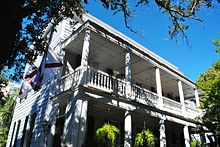Arnoldus Vanderhorst
Arnoldus Vanderhorst (/vænˈdrɑːs/; March 21, 1748 – January 29, 1815) was a general of the South Carolina militia during the Revolutionary War and the 38th Governor of South Carolina from 1794 to 1796.
Arnoldus Vanderhorst | |
|---|---|
.jpg) 1856 portrait by Henry Breintnall Bounetheau | |
| 38th Governor of South Carolina | |
| In office December 17, 1794 – December 8, 1796 | |
| Lieutenant | Lewis Morris |
| Preceded by | William Moultrie |
| Succeeded by | Charles Pinckney |
| Mayor of Charleston, South Carolina | |
| In office 1790 – 1792 | |
| Preceded by | Thomas Jones |
| Succeeded by | John Huger |
| In office 1785 – 1786 | |
| Preceded by | Richard Hutson |
| Succeeded by | John Faucheraud Grimke |
| Member of the South Carolina Senate from Christ Church Parish | |
| In office August 31, 1779 – January 1, 1787 | |
| Member of the South Carolina General Assembly from St. Phillip's and St. Michael's Parish | |
| In office March 25, 1776 – October 17, 1778 | |
| Personal details | |
| Born | March 21, 1748 Christ Church Parish, South Carolina |
| Died | January 29, 1815 (aged 66) Kiawah Island, South Carolina |
| Resting place | St. Michael's Churchyard, Charleston, South Carolina |
| Profession | planter |
Early life and career

Born in Christ Church Parish, Vanderhorst took up planting at his plantation on the eastern half of Kiawah Island in the Lowcountry. He participated in the Revolutionary War as an officer under the command of Francis Marion. During the war, he also served in the South Carolina House of Representatives from 1776 to 1780 and in the South Carolina Senate from 1780 to 1786. After his service in the state Senate, Vanderhorst was elected mayor of Charleston for two terms. He was elected mayor of Charleston, South Carolina on September 12, 1785.[1]
As governor
In 1794, he was elected by the General Assembly as a Federalist to be Governor of South Carolina. During his administration, Vanderhorst pressed the legislature for the revision of the criminal code because the sentences were so harsh that jurors would grant acquittal. In addition, he advocated for a prison system similar to that of the state of Pennsylvania instead of the state jails that were of medieval barbarity.
Later life
After leaving the governorship in 1796, he returned to his plantation on Kiawah Island where he cultivated sea island cotton. Vanderhorst died on January 29, 1815 and he was buried at the St. Michael's churchyard in Charleston. He also proposed the need for a state penitentiary. Later the state penitentiary named Central Correction Institution that was open until 1994.
Archives
Papers of the Vanderhorst family are held at the South Carolina Historical Society[2] and Bristol Archives.[3]
References
- Wallace, David Duncan (1951). South Carolina: A Short History. University of North Carolina Press. pp. 347, 415.
External links
- "Charleston, September 15". State Gazette of South-Carolina. September 15, 1785. p. 2. Retrieved January 24, 2014.
- "Catalogue of the Vanderhorst family papers, 1689-1942" (PDF). South Carolina Historical Society. Archived from the original (PDF) on 15 April 2015. Retrieved 11 April 2014.
- "Catalogue of the Vanderhorst papers". Bristol Record Office. Retrieved 11 April 2014.
| Political offices | ||
|---|---|---|
| Preceded by Richard Hutson |
Mayor of Charleston, South Carolina 1785–1786 |
Succeeded by John Faucheraud Grimké |
| Preceded by Thomas Jones |
Mayor of Charleston, South Carolina 1790–1792 |
Succeeded by John Huger |
| Preceded by William Moultrie |
Governor of South Carolina 1794–1796 |
Succeeded by Charles Pinckney |
